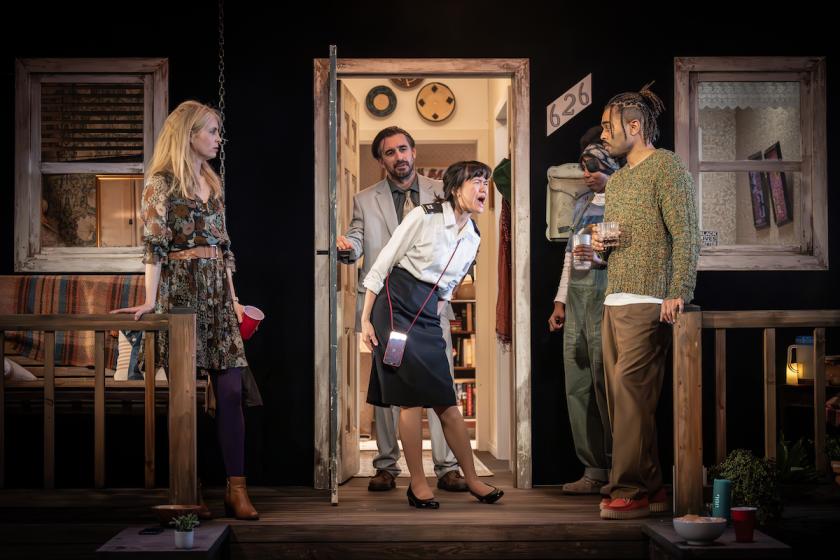I’ve never been one for school reunions, but even if I had kept in touch with former classmates I think that American playwright Branden Jacobs-Jenkins’s The Comeuppance might, just might, lead me to reflect on the wisdom of revisiting the adolescent past.
Originally staged Off-Broadway last summer, the play has been brought to Islington’s Almeida Theatre by its original director, Eric Ting, with a new and excellent British cast. As well as being a reunion play, it’s also a memory play with ghostly elements. Question is, does this mix work on stage?
Set in Autumn 2022, the drama focuses on a group of Maryland friends who are gathering for pre-reunion drinks before setting out, in a limo no less, to their 20th high-school reunion. On the narrow porch of recently bereaved Ursula’s place, we first meet her and Emilio, now an artist based in Berlin, and Caitlin, unhappily married to a older right-winger, before the late arrival of Kristina, once a soldier and now a anaesthetist with five kids, plus an unexpected guest, her cousin Paco, an ex-marine with PTSD. Right from the start, these characters also give voice to the figure of Death, whose presence suggests that one of these friends will leave us for ever – but which one?
Although class reunions offer the chance to catch up, not everyone is equally enthusiastic about getting the latest on old friends: who is married to who; who is divorced from who; who has how many kids? So the gathering’s host, Ursula, sombre after the death of her beloved grandmother and suffering from diabetic eyesight loss, says she doesn’t want to attend, while the offstage Simon has already phoned in his regrets. And while Emilio is curious about what has happened over the years to Caitlin, his former girlfriend, he is openly antagonistic to Paco, who he sees as a militaristic psychopath. By contrast, Kristina, who works all hours, just wants to have fun.
Four of the five characters were once members of a clique called MERGE (Multi-Ethnic Reject Group), a reminder that any state-of-the-nation play about the US must include the issue of race. In the event of this reunion, however, the experiences of prejudice and the emergence of the revitalised Black Lives Matter movement in the wake of the murder of George Floyd are less present in the minds of the characters than more personal memories and attitudes. The one big political issue is that of the military, and what is surely striking to a British theatre audience is the respect that the uniform attracts in American culture, as well as the continuing trauma of Afghanistan and Iraq.
On a more personal level The Comeuppance is about how we as individuals change over a span of two decades, and after COVID. As befits any reunion play, old emotional ties are interrogated, scar tissue is scratched, and clarifications yearned for, especially by Emilio, although not necessarily achieved. Jacobs-Jenkins writes with enormous empathy and perceptiveness, but also at times so subtly as to deny us the desired dramatic punch. While it is predictable that Paco freaks out, the full disclosure about his past interactions with Emilio and Caitlin never really arrives. Likewise, I often felt as if the playwright was so intent on avoiding the clichés of the reunion genre that he denied himself the chance of a full-on climax.
Instead, the looming figure of Death – which is eerily voiced by each character in turn – gives the play a kind of existential and ghostly sensibility, reminding us that we are on the same path and that our appointment with the end can be delayed, but will eventually have to be honoured. What this adds to a play about memory and high jinks at high school is unclear, at least to me, but it results in a 90-minute piece being stretched to two hours. By the end, I was beginning to wonder what the point of it all was. For all the mentions of pandemic, violence (Columbine and 9/11) and mid-life regret, the final effect is distinctly so-whatish.
So despite the good jokes about young sexuality and mooning, and the typically awkward teenage ideas about who is, or is not, gay, the playwright’s humanity and fairness tends to get in the way of the drama. Every character gets a chance to tell their truth, everybody has a well-fleshed out backstory, and everyone gets to say something about what happened to them over the past 20 years. This leads to a complex picture of credible people, but drains the piece of drama. For example, Emilio is shy about talking about his art, which leads us to expect a revelation about it that never really lands. Even the occurrence of an epileptic fit defuses tension rather than raising it.
Jacobs-Jenkins’s subtle naturalism is well served by Ting’s careful, and rather relaxed, production. On a cramped porch, designed by Arnulfo Maldonado, with its limp American flag on the corner, the actors deliver convincing performances: Anthony Walsh’s critical and incisive Emilio contrasts well with Tamara Lawrance’s laidback Ursula, Yolanda Kettle’s evasive Caitlin and Katie Leung’s frantic Kristina. Ferdinand Kingsley lends Paco a palpable sense of danger and unpredictability. They make this an interesting and realistic theatre experience, but the play remains inconclusive and, for me, unsatisfying. In the end, spoiler alert, no one really gets their comeuppance.















Add comment